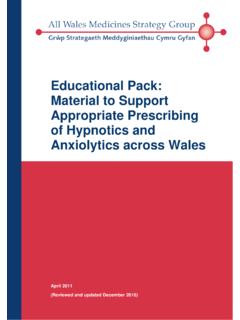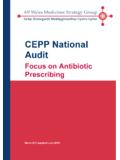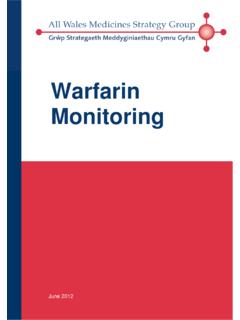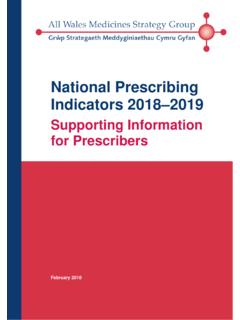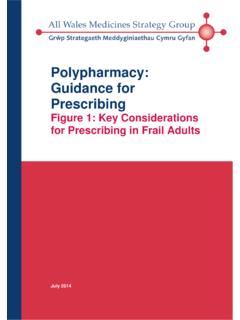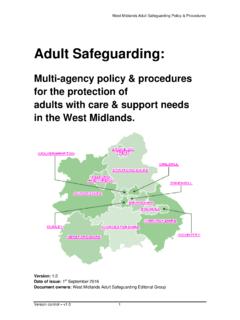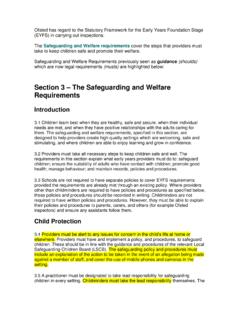Transcription of Safeguarding Users of Opioid Patches by …
1 Safeguarding Users of Opioid Patches by standardising Patient/Caregiver Counselling September 2016. This document has been prepared by a multiprofessional collaborative group, based on original work prepared by Janet Thomas (Patient Safety Pharmacist, Wrexham Maelor Hospital), with support from the All Wales Prescribing Advisory Group (AWPAG) and the All Wales Therapeutics and Toxicology Centre (AWTTC). This document has subsequently been endorsed by the All Wales Medicines Strategy Group (AWMSG). Please direct any queries to AWTTC: All Wales Therapeutics and Toxicology Centre University Hospital Llandough Penlan Road Llandough Vale of Glamorgan CF64 2XX. 029 2071 6900. This document should be cited as: All Wales Medicines Strategy Group.
2 Safeguarding Users of Opioid Patches by standardising Patient/Caregiver Counselling. September 2016. Safeguarding Users of Opioid Patches by standardising Patient/Caregiver Counselling CONTENTS. BACKGROUND .. 2. Opioid PATCH SAFETY: COUNSELLING CHECKLIST .. 3. Opioid PATCH INFORMATION TO KEEP patients SAFE .. 5. REFERENCES .. 9. Page 1 of 9. All Wales Medicines Strategy Group BACKGROUND. The aim of the counselling checklist is to assist healthcare professionals, working in community pharmacies, primary care and secondary care, in the essential counselling of patients on the safe and effective use of Opioid Patches . The inclusion of a checklist for patients /carers to refer to following counselling will also encourage the safe use of Opioid Patches .
3 Fentanyl Patches are strong Opioid analgesics indicated for chronic intractable pain. Buprenorphine Patches are strong opioids indicated for moderate to severe chronic cancer pain and moderate to severe pain unresponsive to non- Opioid analgesics1. Fentanyl is a Schedule 2 Controlled Drug and buprenorphine is a Schedule 3. Controlled Drug2. In 2008, the National Patient Safety Agency published a Rapid Response Report, alerting all healthcare professionals to the risks of patients receiving unsafe doses of Opioid medicines3. In 2014, the Medicines and Healthcare products Regulatory Agency (MHRA) highlighted the risk of inadvertent exposure to fentanyl patches4, emphasising the need for providing information to patients and caregivers regarding the safe handling of Patches .
4 The MHRA had also previously issued a drug safety update in September 2008, detailing serious and fatal overdose from dosing errors, accidental exposure and inappropriate use5. In December 2015, Welsh Government issued a Patient Safety Notice regarding the risk of harm from the inappropriate use and disposal of fentanyl patches6. It is important that patients who are prescribed Opioid Patches are appropriately counselled on the safe use, storage and disposal of their medicine, so as to reduce the risk of overdose from dosing errors, accidental exposure and inappropriate use7. If appropriate, it is beneficial for a patient's carer to be involved in any counselling, especially as symptoms experienced in the event of overdose may prevent a patient from seeking help.
5 In community pharmacies, ascertain who is collecting the medication and make a record of it. patients and carers should be told to keep the manufacturer's patient information leaflet (PIL) for reference. It is important that information regarding safe use and side effects is reiterated when patients collect their prescriptions, even for those using Opioid Patches long-term. Consider documenting that the checklist has been discussed with the patient/carer ( by using a Read Code). The Patient Medication Record (PMR) or a Medicines Use Review (MUR) form can also be used to document counselling given. Information on the initiation of treatment with transdermal opioids can be found in various resources, including the Summary of Product Characteristics (SPC), British National Formulary (BNF), and Monthly Index of Medical Specialities (MIMS).
6 Opioids should be withdrawn gradually unless there are signs and symptoms of Opioid toxicity1,5. Opioid Patches may affect the patient's ability to drive and operate machinery; patients should not drive until they know how the medicine affects them. For further advice, see Department for Transport guidance for healthcare professionals on drug driving. Various medicines can interact with opioids and potentiate the associated risks of their use1 (consult the BNF or SPC for full details); a careful drug history in a patient unfamiliar to you is therefore essential, even if it means contacting the prescriber. This is particularly important for patients new to Opioid Patches . It is good practice to record any over the counter (OTC) items supplied to the patient and check these for interactions with Opioid Patches .
7 It is important to establish whether there are any concurrent co-morbidities, and Opioid Patches should be used with extra caution in special populations (consult the BNF or SPC for full details). If you have any concerns/suspicions regarding a particular patient and patch abuse potential, please contact the prescriber or your local substance misuse specialist team. Page 2 of 9. Safeguarding Users of Opioid Patches by standardising Patient/Caregiver Counselling Patient details Opioid PATCH SAFETY: COUNSELLING CHECKLIST. If the patient is calling back, please attach a counselling required note. Appropriate health professional to issue prescriptions ( assistant technical officers or students are not to issue these prescriptions without supervision).
8 For completion by the clinical checker Yes No Comment A Has the patient received this treatment before? Check that not Opioid -naive B Has the dose changed? C Is the brand of Opioid patch the same as previously used? D Double-check for drug interactions when new items are prescribed E Has the patient been given information on breakthrough pain relief? F Presence of PIL within the packaging Counselling checklist: For completion by the counsellor Already Check the patient knows: Yes No aware a How many Patches to apply and how often To choose the patch application site carefully and to not apply to the same b site twice in a row (see PIL). To not apply the patch to broken, irritated or irradiated skin.
9 Ensure c skin is non-hairy and dry before application. If necessary, cut hair with scissors; do not shave the area before applying a patch d Never to cut the patch The process for applying the patch (refer to PIL): Remove old patch and carefully fold it over so sticky sides are stuck together. Put back in its original pouch and safely dispose of it out of e discovery of children/animals Apply new patch (avoid touching sticky sides). Press patch firmly in place for 30 60 seconds and wash hands afterwards f That it may be helpful to use a calendar to record day of application g That the patch may not start or stop working straight away If the patch falls off, start another patch.
10 Do not re-use patch. If the edge of h the patch starts to peel, use suitable tape ( white surgical tape, transparent adhesive film dressing) to secure the patch To keep Patches out of sight/reach/discovery of children and animals and to seek immediate medical attention if patch is swallowed or applied to the skin of anyone other than the patient. Patches are not i plasters! Incidents have involved children mimicking what they have seen others do. Deaths have occurred where children have removed Patches from sleeping adults and swallowed discarded/ fallen-off' Patches The effect of heat on patch. Avoid applying external heat sources against/near the patch, hot water bottles, heat pads or heat blankets.



